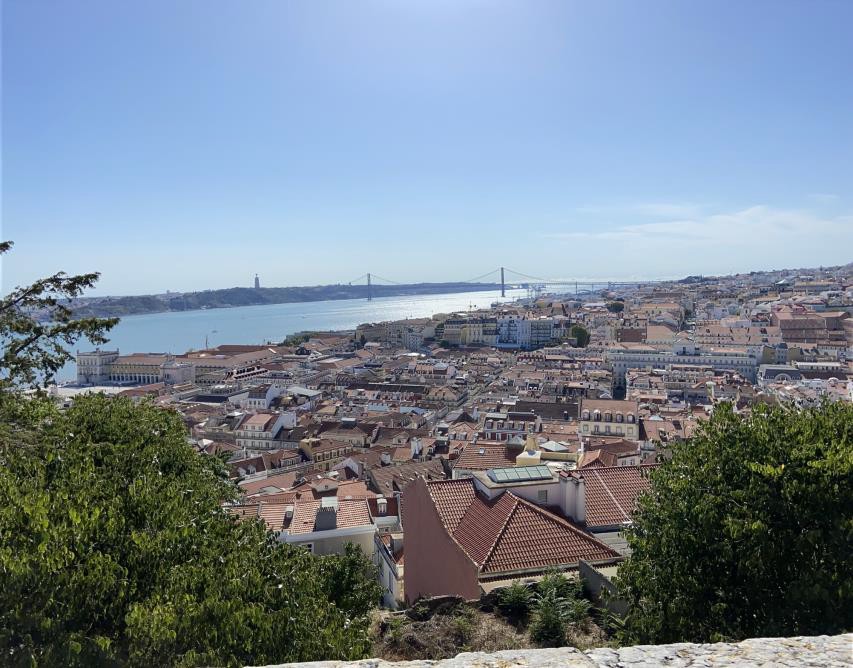The Marquis
( skip to the next section of you’re tired of the 1700’s)
Before the Marquis de Pombal was the Marquis, he was merely Sebastião José de Carvalho e Melo, son of a country squire and the nephew of an influential cleric. He was exposed to enlightened philosophies in his youth through soirées hosted by his father. Carvalho studied law but found the material tedious and his professors found him undisciplined. He didn’t finish his studies and instead joined the military.

View across the Tagus River
In 1723, at the age of 24, Carvalho eloped with a widow, ten years his senior. She was from one of the most distinguished and wealthy families in Portugal. Prior to the elopement, he had courted another wealthy young woman, a member of the Távora family. He was snubbed and rebuffed.
The insult would not be forgotten.
Now as a titled man of leisure, he studied history. Family connections got him an introduction to King João V. In 1739, he was appointed Minister Plenipotentiary to London. Within three months of his arrival, his wife died. He immersed himself in negotiating better trade deals, understanding Britain’s fiscal system and studying mercantilism.

In 1745, while Minister to Vienna, he met his second wife. She was an ever more propitious match, as she was the personal friend of the Austrian princess who had become the Queen of Portugal.
Hence, the son of a country squire became Portugal’s Secretary of State.
The Marquis made incredible strides in modernizing Portugal and improving economic conditions. But, he also made powerful enemies.
A botched, possible assassination of King José in 1758 was traced, by Carvalho, to the Távora family. The family that had snubbed him in his youth. Revenge was exacted as the entire family was prosecuted and executed in a most gruesome manner. The nobles and grandees of Portugal were stunned and horrified.
In 1777, King José died. The minister, now the Marquis, had lost his sponsor and protector. The new Queen Regent, Maria I, dismissed the Marquis, stripped him of all his offices and exiled him to his estate.

The nobles returned and the aristocracy reasserted it’s power. The Jesuits returned. Education suffered. Many of the progressive, economic programs failed as the human infrastructure and support wasn’t in place.
However, slavery had been abolished, Lisbon was being rebuilt and the Holy Office of the Inquisition had ended.
Skip ahead to the late 1900’s. Portugal had endured weak rulers, despots and one of the longest dictatorships in European history.
At the end of their dark days, the Portuguese diaspora rejoices and 3 million Portuguese from former colonies and throughout the world return to the homeland. The population balloons from 6 to 9 Million!
Lisbon Today
Lisbon is a gleaming city, awash in shades of white. The beautiful limestone mosaic walkways, tiled buildings and pastel walls reflect and play with the sunlight.

The walkways are quite wide and interspersed with plazas. Basalt tiles and occasionally pink granite is used for the motifs. The patterns are unique and quintessentially reflect Lisbon.


Just down the hill from the Carmel Square is an area dedicated to three significant Portuguese writers/ poets. The Café Brasilia on the Rua Garrett hosts a bronze statue of Fernando Pessoa. The small adjacent square captures his image in the tile.


Pessoa was educated in South Africa and won a prestigious award for an English essay. As a young child, he had already developed different personas, each with a unique style of prose. He called each personality a heteronym. He would have over 70 heteronyms during his brief life. His three primary personas were Alberto Caeiro, a rural, uneducated poet of great ideas who wrote in free verse; Ricardo Reis, a physician who composed formal odes; and Álvaro de Campos, an adventurous London-based naval engineer. It is thought he suffered from multiple personality disorder. He could thoroughly immerse himself in
Bronze of Pessoa outside Lisbon cafe
each personality, even his penmanship appeared unique to the heteronym. Pessoa died ignominiously of cirrhosis at age 47. His poetry became famous after his death.
One of Portugal’s cultural masterpieces is Os Lusiads, an epic poem describing Vasco de Gama’s sea voyage to India. The poet, Luís Vaz de Camões, took his new bride and nearly completed manuscript on
a voyage. The ship encountered rough seas and was sunk. Faced with the decision of what to save, his bride or his life’s work, he chose the manuscript. Today, every Portuguese student reads the Lusiads.
And I still haven’t mention the incredible local cuisine!
The pastel de nata is an iconic Portuguese treat. The palm sized tart dates back to the 16th century when convents prepared many sweets. It’s rich and slightly sweet with a crisp pastry shell. Many recipes mention puff pastry as the shell but the secret of the pastry is pork fat. I’m off to a local cooking class next week to see if its possible to reproduce the flavor and texture of the tart in Colorado. The breakfast of champions in Lisbon is a Bica and a Patel de nata.. Bica is the local acronym for an espresso with sugar.

Café Brasilia was opened in 1905 to sell real Brazilian coffee. It was the first shop to offer a strong espresso drink. It originally wasn’t very popular, even though the Portuguese roasting process yields a smoother flavor, similar to an Italian lungo coffee. The owner offered a free cup of coffee for every kilogram of ground coffee purchased. The locals found the beverage bitter so a placard was mounted with the phrase
Bebo Isso Com Açúcar
The BICA means literally “Drink it with sugar”. The people of Lisbon drank the espresso with sugar and BICA became a dietary stable
Until next time when you’ll see much more food porn.